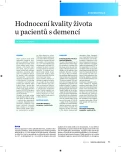Clostridium difficile – nebezpečný patogén pro starší pacienty
Autoři:
K. Bielaková; H. Matějovská-Kubešová; P. Weber; D. Weberová
Působiště autorů:
Masaryk University
; Clinic of Geriatric Medicine and General Medicine, The University hospital Brno
Vyšlo v časopise:
Geriatrie a Gerontologie 2014, 3, č. 4: 171-174
Kategorie:
Původní práce/studie
Souhrn
Infekce způsobená Clostridium difficile (CDI) se stává závažným problémem zejména u geriatrických pacientů, kteří jsou významnou rizikovou skupinou. Cílem této práce je zhodnotit výskyt rizikových faktorů u seniorů, které vedou k onemocnění CDI.
Zkoumaný soubor tvořilo 235 seniorů ve věkové kategorie nad 65 let s potvrzenou diagnózou CDI. Pro diagnózu CDI byl rozhodující nález toxinu A a B ve stolici pacientů, či autopticky potvrzená CDI. Soubor geriatrických pacientů s klostridiovou infekcí tvořilo 148 žen (62,98 %) a 87 mužů (37,02 %). Rizikovým faktorem bylo cévní onemocnění mozku, demence, přítomnost dekubitů a imobilita. V práci se potvrdil jako statisticky významný faktor při MMSE test, ADL test, MNA-SF test a Charlsonův index komorbidity.
Klíčová slova:
Clostridium difficile – geriatrický pacient – antibiotická terapie – pseudomembranózni kolitida
Zdroje
1. Jones MA, Kuijper EJ, Wilcox M.H. Clostridium difficile: a European perspective. J Infect. 2013; 66(2):115–28.
2. Depestel DD, Aronoff DM. Epidemiology of Clostridium difficile Infection. J Pharm Pract. 2013;26(5): 464–475.
3. Dupont HL, Garey KW. Clostridium difficile infection: an emerging epidemic with more questions than answers. Future Microbiol. 2010; 5(8):1153–6.
4. Khana S, Pardi DS. The growing incidence and severity of Clostridium difficile infection in inpatient and outpatient settings. Expert Rev Gastroenterol Hepatol. 2010; 4(4):409–16
5. Zilberberg MD, Shorr AF, Kollef MH. Increase in adult Clostridium difficile–related hospitalizations and case-fatality rate, United States, 2000–2005. Emerg Infect Dis. 2008; 14(6): 929–931.
6. Miller M, Gravel D, Mulvey M et al. Health care-associated Clostridium difficile infection in Canada: patient age and infecting strain type are highly predictive of severe outcome and mortality. Clin Infect Dis. 2010; 50(2):194–201.
7. Cober ED, Malani PN. Clostridium difficile infection in the „oldest“ old: clinical outcomes in patients aged 80 and older. J Am Geriatr Soc. 2009; 57(4):659–62.
8. Raveh D, Rabinowitz B, Breuer GS, Rudensky B, Yinnon AM. Risk factors for Clostridium difficile toxin-positive nosocomial diarrhoea. Int J Antimicrob Agents. 2006; 28(3):231–7.
9. Pépin J, Valiquette L, Alary ME et al. Clostridium difficile-associated diarrhoea in a region Quebec from 1991 to 2003: a changing pattern of disease severity. CMAJ. 2004; 171(5):466–472.
10. Vaishnavi C. Clinical spectrum & pathogenesis of Clostridium difficile associated diseases. Indian J Med Res. 2010; 31 : 487–99.
11. Zilberberg MD, Shorr AF, Micek ST, Doherty JA, Kollef MH. Clostridium difficile-associated disease and mortality among the elderly critically ill. Crit Care Med. 2009; 37(9):2583–9.
Štítky
Geriatrie a gerontologie Praktické lékařství pro dospělé ProtetikaČlánek vyšel v časopise
Geriatrie a Gerontologie

2014 Číslo 4
- Isoprinosin je bezpečný a účinný v léčbě pacientů s akutní respirační virovou infekcí
- Není statin jako statin aneb praktický přehled rozdílů jednotlivých molekul
- Metamizol jako analgetikum první volby: kdy, pro koho, jak a proč?
- S MUDr. Kamilou Kotíkovou o novém pilíři včasné diagnostiky osteoporózy − denzitometrii v gynekologické praxi
- Mirtazapin v léčbě deprese spojené s nadměrným užíváním alkoholu
Nejčtenější v tomto čísle
- Normocytární a makrocytární anemie v seniorském věku
- Dehydratace ve stáří
- Anemie z nedostatku železa a geriatrická medicína
- Výživa ve stáří
